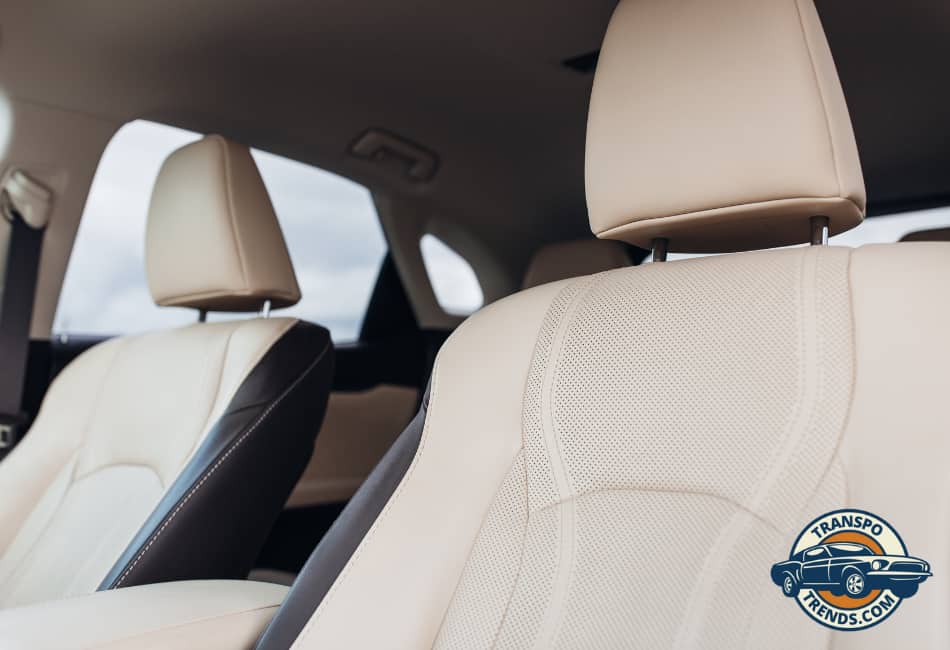As an avid road-tripper who has spent countless hours behind the wheel, I understand the immense value of car comfort.
One of my favorite vehicle features is undoubtedly the ventilated seats, a luxury that turns summer drives into a cool, comfortable experience.
But like any car enthusiast, I also value seat covers’ aesthetics and protection. This brings us to a common dilemma many motorists face: Do seat covers work with ventilated seats?
Through this guide, we will delve into the details of ventilated seats, their benefits, the purpose of seat covers, and most importantly, their compatibility.
So buckle up as we embark on this journey to finding the perfect balance between comfort, protection, and style for your car seats.
Understanding Ventilated Seats
Ventilated seats are a remarkable innovation in the automotive industry, designed to make every driving experience more comfortable, especially on those hot summer days.
Just imagine driving under the scorching sun, and while the temperature outside is unbearable, you’re sitting comfortably in your car with a cooling sensation beneath you. That’s the magic of ventilated seats!
But how do they work? Well, let’s dive into the specifics. Ventilated seats function by integrating a series of fans into the seat.
These fans push air through a fine perforated layer on the seat surface, distributing a cool breeze directly to the body and helping the driver and passengers keep their cool.
I remember the first time I experienced the sheer luxury of ventilated seats. I was on a long drive across the state during a particularly hot summer. I could feel the heat creeping in despite cranking up the air conditioning.
Then, I switched on the ventilated seats, and the transformation was instant. The discomfort caused by the heat was replaced with a soothing coolness that changed the entire course of the drive. This type of comfort makes ventilated seats a must-have for any car enthusiast.
Benefits of Ventilated Seats
Ventilated seats are more than just a luxury; they serve a practical benefit that enhances your driving experience in numerous ways.
1. Comfort and Luxurious Touch
First and foremost, the comfort and luxury that ventilated seats offer are unparalleled. They transform your vehicle into a haven of relaxation, making every long or short journey an absolute pleasure.
The cooling sensation they provide alleviates discomfort caused by heat, ensuring that you remain comfortable regardless of the weather conditions outside.
They give a sense of opulence, turning even the most mundane drives into a premium experience.
2. Pleasant and Sweat-Free Environment
Apart from comfort, ventilated seats play a major role in maintaining a pleasant and sweat-free environment inside your car.
Traditional seats, especially leather ones, can cause you to sweat on hot days, making the drive uncomfortable and potentially leading to unpleasant odors in the car.
Ventilated seats solve this issue by providing a constant flow of air that keeps you cool and prevents sweating.
This not only makes your drive more enjoyable but also helps in keeping your car clean and odor-free.
The days of stepping out of your vehicle drenched in sweat are long gone, thanks to the innovation of ventilated seats.
3. Enhanced Safety
In addition to comfort and sweat-free rides, ventilated seats also offer an enhanced level of safety.
They help combat fatigue and enhance driving alertness by providing a cooling sensation.
This can be especially useful on long journeys where the driver is prone to getting tired from the heat and lack of fresh air.
Ventilated seats also help to maintain a perfect body posture during long drives, thus preventing any potential strain on your back and neck.
Therefore, the improved comfort offered by ventilated seats makes your journey enjoyable and keeps you safe on the roads.
About Seat Covers
Seat covers are protective layers designed to safeguard your vehicle’s upholstery from damage, enhance comfort, and add an aesthetic appeal to your car’s interior. They come in various types, each offering unique benefits and uses.
Seat Cover Materials
- Leather Seat Covers:
Leather seat covers exude luxury and sophistication. They are durable, easy to clean, and resistant to stains and spills.
However, they can get hot in summer and cold in winter and may require regular maintenance to keep them looking good.
- Fabric Seat Covers:
Fabric seat covers are popular due to their affordability and versatility. They come in many designs and colors, making them perfect for customization. However, they are less resistant to spills and can be harder to clean than leather.
- Neoprene Seat Covers:
Neoprene seat covers are water-resistant, making them perfect for individuals who live in rainy areas or enjoy outdoor activities.
They offer a snug fit and good comfort but might not offer the same level of sophistication as leather.
Purpose of Using Seat Covers
Seat covers serve a multitude of purposes.
- They protect the original upholstery from wear and tear,
- spills,
- and UV rays.
Seat covers also enhance the car’s comfort, with materials like neoprene offering additional cushioning. They can also be used to personalize the car’s interior to the owner’s taste.
Pros and Cons of Each Seat Cover Material
- Leather Seat Covers:
Pros: Durable, easy to clean, luxurious look.
Cons: Can be hot in summer and cold in winter, requires regular maintenance.
- Fabric Seat Covers:
Pros: Affordable, versatile designs.
Cons: Less spill-resistant, harder to clean.
- Neoprene Seat Covers:
Pros: Water-resistant, comfortable, good fit.
Cons: Not as sophisticated as leather.
Compatibility of Seat Covers with Ventilated Seats
Seat covers can have a significant impact on the functionality of ventilated seats.
Understanding their compatibility is essential to ensure you maintain the comfort and functionality of your car seats. Here’s a detailed explanation:
Ventilated seats allow air to circulate through the seat fabric, providing a cooling effect. When a seat cover is applied, this can inhibit the airflow, decreasing the effectiveness of the ventilation.
Therefore, choosing the right seat cover material is crucial for maintaining the ventilation system’s functionality.
1. Leather Seat Covers and Ventilated Seats
While luxurious and easy to clean, leather seat covers may not be the best choice for ventilated seats.
The denseness of the leather can restrict the airflow, reducing the cooling effect of the ventilation system.
2. Fabric Seat Covers and Ventilated Seats
Due to their looser weave, fabric seat covers are more compatible with ventilated seats.
They allow better air circulation through the fabric, maintaining the functionality of the ventilation system.
However, they require more maintenance due to their susceptibility to spills and stains.
3. Neoprene Seat Covers and Ventilated Seats
Neoprene seat covers, while being comfortable and snug-fitting, can limit the effectiveness of ventilated seats.
Like leather, neoprene is dense, potentially inhibiting the airflow necessary for the seats’ cooling function.
4. Faux Leather Seat Covers and Ventilated Seats
Faux leather seat covers offer a combination of the comfort and look of leather with better air circulation.
Unlike leather, faux leather is breathable, allowing more airflow to the seats while providing additional protection against dirt and spills.
While not as durable as genuine leather, faux leather seat covers are still cost-effective for ventilated seats.
5. Mesh Seat Covers and Ventilated Seats
Mesh seat covers are ideal for ventilated seats due to their breathability, durability, and comfort.
The open weave of mesh allows for maximum air circulation while still providing adequate protection against dirt and spills.
Additionally, mesh is lightweight yet durable, making it a great choice for long road trips.
Factors to Consider When Choosing Seat Covers for Ventilated Seats
When choosing seat covers for your ventilated seats, consider the following factors: Material, Breathability, Fit, and ease of installation.
Material
The material of the seat cover is a crucial factor. Different materials have varying levels of durability, susceptibility to stains, and compatibility with ventilation systems.
Opting for a material that balances your personal preferences, car environment, and ventilation needs is essential.
Breathability
Breathability is undoubtedly a key factor when selecting seat covers for ventilated seats.
Materials like mesh and breathable faux leather allow for greater airflow, ensuring that the cooling effect of the ventilation is not hindered.
Fit and Ease of Installation
Finally, the fit and ease of installation are vital considerations. A well-fitted seat cover enhances the aesthetics of your car interior and ensures the functionality of your ventilated seats is not impaired.
Recommendations – Top Picks
When you’re hunting for seat covers compatible with ventilated seats, there are a few standout options to consider. Each of these recommendations balances breathability, durability, and a good fit:
1. FH Group Sports Fabric Seat Covers
Praised for their breathability and sporty aesthetic, these seat covers from FH Group offer an excellent blend of style and functionality.
The high-quality fabric is breathable and resistant to dirt and spills, making it an ideal choice for ventilated seats.
You can check it out here on Amazon if you want one!
2. BDK PolyPro Seat Covers
Thanks to their universal fit and protective qualities, BDK’s PolyPro seat covers are another worthy contender.
Made with a breathable blend of polyester fabric, these covers ensure the efficient operation of your ventilation system.
3. Aierxuan 5pcs Car Seat Covers Full Set
Aierxuan’s 5-pcs full set of seat covers incorporate a breathable combination of leather and fabric.
Apart from their appealing aesthetics, these covers are also easy to install and don’t interfere with the function of ventilated seats.
Remember, the best seat cover for your ventilated seats will depend on your personal preferences and the specific needs of your car’s environment. Always consider the factors discussed earlier when making your choice.

